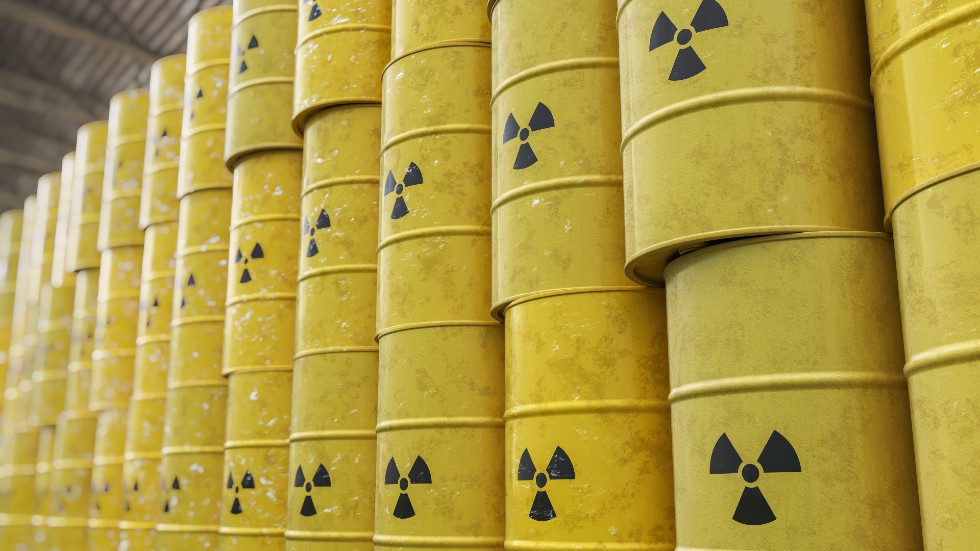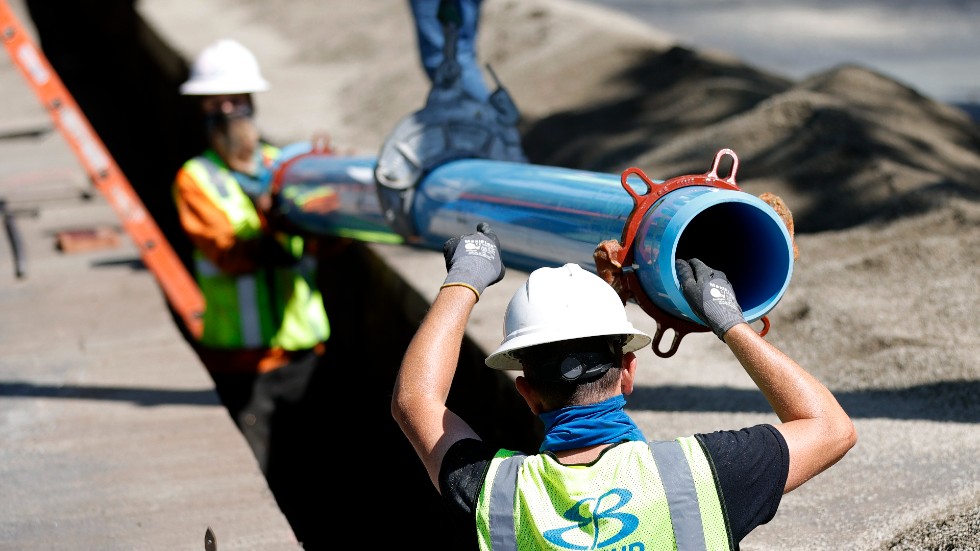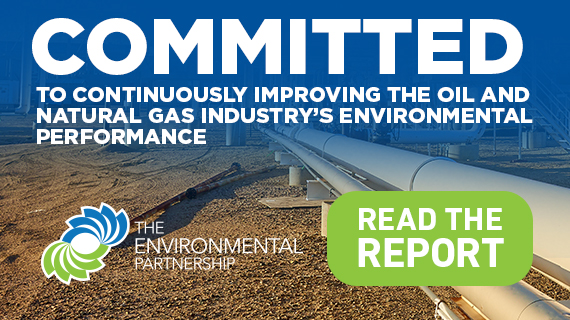Equilibrium/Sustainability — Presented by The American Petroleum Institute — Dems demand accounting from Big Oil
Today is Friday. Welcome to Equilibrium, a newsletter that tracks the growing global battle over the future of sustainability. Subscribe here: digital-staging.thehill.com/newsletter-signup.
Two Democratic leaders called upon the CEOs of major oil companies to testify before Congress about whether they “suppressed information about their roles in climate change,” Zack Budryk reported for The Hill.
“We need an accounting,” House Oversight and Reform Committee Chairman Ro Khanna (D-Calif.) told The Hill, stressing that companies are making public statements about the importance of sustainability while telling their boards that oil production will continue.
Today, we’re looking at other tough political accounting. First, there’s the cross-border backlash from a Canadian nuclear waste storage proposal on the Great Lakes. Then we’ll spend some more time in Canada and across the Atlantic, to see how three countries are aligning climate-forward policies with their powerful fossil fuel industries.
For Equilibrium, we are Saul Elbein and Sharon Udasin. Please send tips or comments to Saul at selbein@digital-staging.thehill.com or Sharon at sudasin@digital-staging.thehill.com. Follow us on Twitter: @saul_elbein and @sharonudasin.
Let’s get to it.
Bipartisan group asks Biden to stop Canadian nuclear storage plans

Rep. Dan Kildee (D-Mich.) is calling on the Biden administration to stop the Canadian government from storing nuclear waste in the Great Lakes Basin.
The Nuclear Waste Management Organization (NWMO), a nonprofit established by the Canadian government, recently unveiled plans to construct a site to “permanently store more than 50,000 tons of high-level nuclear waste” in the town of South Bruce, Ontario, Kildee’s office said. South Bruce is about 30 miles east of Lake Huron.
Kildee in a release from his office described high-level nuclear waste as “the most dangerous form of nuclear waste,” and said that if an accident involving such waste occurred in the Great Lakes region, it could take a catastrophic toll on public health in surrounding U.S. and Canadian communities.
“The Great Lakes are central to our way of life, and permanently storing nuclear waste so close to our shared waterways puts our economies and millions of jobs at risk in the fishing, boating and tourism industries,” Kildee said in a statement.
Bipartisan support from the Great Lakes region: Kildee is offering a bipartisan resolution asking President Biden to work with the Canadian government to stop the plans for the storage. The resolution is co-sponsored by 11 Democrats and nine Republicans from states surrounding the Great Lakes.
“From recreational activities to economic opportunities, the Great Lakes are integral to our daily lives, and a spill of hazardous materials would be devastating to communities across the state,” one of the co-sponsors, Rep. Peter Meijer (R-Mich.), said in a statement.
Tribal Chief Tim J. Davis, of the Michigan-based Saginaw Chippewa Indian Tribe, added his concerns, noting his community’s ongoing work “to eliminate the continuing threat of nuclear waste being deposited into Mother Earth” so close to the planet’s largest freshwater basin.
For clean water and economic stability: Not only do the Great Lakes provide clean drinking water to more than 40 million people in the U.S. and Canada, but they also generate more than $82 billion in economic activity annually, Marc Smith of the National Wildlife Federation said in a statement.
PRESENTED BY API
The Environmental Partnership recently released its annual report highlighting its new flare management program that reported a 50 percent reduction in flare volumes from 2019 to 2020. Read more.
CANADA SAYS THEY’RE ACTUALLY DECREASING RISK
Canada pushes back: In response to Kildee’s announcement, a spokeswoman for Canada’s NMWO told Equilibrium that the organization has reached out to the congressman directly to offer him a briefing on the plans and expressed disappointment that he had not been in touch for more information.
“The entire purpose of Canada’s plan — the reason we are investing time, effort and money to implement it — is to protect people and the environment, including the Great Lakes,” the spokeswoman said in a statement. “The used fuel will be moved from the surface, further from the lake than where it is now, and placed within a system of barriers to ensure passive safety for generations.”
“Consistent with best practice”: The NMWO, she explained, is considering two potential landlocked spaces for a deep geological repository and that plans would only go forward if they can be demonstrated as safe and if they gain the host community’s agreement. Such long-term storage projects, deep underground, are “consistent with best practice around the world” and preferred by the scientific community, she said.
The second site is in Ignace, Ontario, about 80 miles from Lake Superior, Mich.,-based WSGW Newsradio reported.
Last words: “The U.S. has dozens of high-level nuclear waste storage sites along the Great Lakes and has had them for many years,” the NMWO spokeswoman said. “In Canada we are doing the responsible thing by implementing plans to place used nuclear fuel in a deep geological repository which, scientists from around the world agree, would permanently protect people and the environment including the lakes.”
To read the full story on Kildee’s bipartisan resolution, please click here.
Climate moderates benefit most from the difficulties of quitting oil
 Climate has been the focus of several global election campaigns this month, as three countries have sought to balance the survival of their powerful fossil fuel-based industries with the pressing — and popular — need to take aggressive climate action.
Climate has been the focus of several global election campaigns this month, as three countries have sought to balance the survival of their powerful fossil fuel-based industries with the pressing — and popular — need to take aggressive climate action. In Monday’s elections in Norway — and the upcoming elections in Canada and Germany — climate moderates seem to have the upper hand.
First stop: Norway. A bloc of center-left policies won Norway’s national elections on Monday behind promises to invest in green energy, hydrogen fuel and carbon capture and storage technology, The Associated Press reported.
All of these policies are consistent with Norway keeping its place as a major fossil fuel exporter — the third largest behind Russia and Qatar according to Time.
Cognitive dissonance: Norway seeks “a climate-friendly image at home and abroad, while being unable to curb its domestic emissions and maintaining fossil fuel exports at relatively high levels,” the research firm IPSOS found in 2017.
While virtually all of the country’s domestic energy is generated from renewable sources like hydropower and wind, the country’s undersea oil and gas reserves account for an outsized share of both its economy and its emissions, including a $1.4 trillion sovereign wealth fund and about 7 percent of its employment, according to Time.
Norwegian oil and gas is a major source of emissions both when it is produced and when it is burned abroad. In 2020, the burning of Norwegian-exported fossil fuels led to 30 times the country’s greenhouse gas emissions, according to Public Radio International.
A tough compromise: The election came down to specific policies, particularly around whether new oil and gas drilling would continue in the North Sea, Time reported.
The Conservatives said yes, the Greens said no and the victorious center-left led by Labour hedged with a plan that would involve a gradual, negotiated slowdown in oil as new green energy came online.
“We want the oil and gas industry to know that there will be no surprising political changes with Labour,” party deputy Hadia Tajik told Reuters before the election.
Canada faces the same paradox. In the wake of a summer of drought and wildfire, all of Canada’s parties — including, for the first time, the Conservatives — struggle to balance the climate emergency against a highly polluting, carbon intensive oil sector that makes up 10 percent of national GDP, Reuters reported.
‘THE SIMULATION OF DOING SOMETHING’
A climate report card: In terms of top-line cuts, the Green and left-leaning New Democratic Parties lead the pack, wrote climate scientist Karen Hayhoe in Chatelaine.
But she gave them both a C- in feasibility, noting neither had practical plans for realizing the transitions they envisioned.
Stronger were the Conservatives, she wrote. While their ambitions are limited — as the only party whose emissions reduction target (30 percent) wouldn’t enable Canada to meet Paris Climate Agreement commitments — they have a practical plan to do it.
The Liberals, meanwhile, have proposed 40-45 percent cuts by 2030. Hayhoe gave them an A- for the feasibility of those cuts.
Greens face uphill battle in Germany: As climate concerns have spread across the political spectrum, that has diffused the power of traditionally eco-conscious parties like the Greens — who spent a few weeks at the top of the polls after last month’s devastating floods, the Financial Times reported at the time.
The Greens argue that their leader, Annalena Baerbock, makes up for a lack of government experience with a strong plan and clarity of purpose, and they are proposing an aggressive policy of state support for decarbonizing Germany’s steel and auto industries, Time reported.
Despite nearly universal rhetoric on climate projection, no party had advanced a platform that would fulfill the country’s Paris Agreement contributions toward keeping warming below 1.5 degrees Celsius, the Time reported.
And the Green Party’s midsummer lead in the polls has faded — even in the areas hit hardest by the flood, the Financial Times reported.
Last words: Student activist Pauline Brünger told the Times that the new universality of climate politics now stands in the way of action.
“All parties have perfected the simulation of doing something,” she said.
PRESENTED BY API
The Environmental Partnership recently released its annual report highlighting its new flare management program that reported a 50 percent reduction in flare volumes from 2019 to 2020. Read more.
Follow-up Friday

Our weekly tying-off of loose threads from the week.
Biden’s push to eliminate lead pipes won’t be smooth sailing
- Earlier this week, we looked at how California grid limits make access to solar energy even more unequal. Another piece of critical American infrastructure, the water pipeline, is likewise becoming rife with social concerns.
- Although the Biden administration’s bipartisan infrastructure plan proposes spending tens of billions of dollars on removing every lead pipe nationwide, follow-through would depend largely on local officials, The Wall Street Journal reported.
- In Chicago, for example, which has more lead pipes than any other city, a replacement program has already begun. Homeowners pay most of the replacement cost, although the city offers a grant program for low-income residents, the Journal reported.
- Nonetheless, many residents don’t view lead pipes as a health risk. Others are worried about hidden costs or don’t trust the government, due to immigration status, according to the Journal.
Healthier diet could decrease emissions, but remains unattainable for low-income minority groups: study
- Another issue we focused on this week was a call from U.N. agencies to repurpose agricultural support in a way that positively transforms the global food system.
- Related to that system, and accessibility to diverse foods within it, Cardiff University researchers found that a healthy diet with lower environmental impacts is attainable for most of the U.S. public, Phys.org reported.
- However, such a diet is unaffordable for up to 38 percent of Black and Hispanic people in the lowest education and income groups — twice the percentage of white individuals in these categories, according to the study, published in Nature Food.
- An optimized diet — more whole grains, dairy, fruits, vegetables, seafood and plant proteins — could be achieved for 95 percent of the U.S. population, the researchers found.
- Such a diet, they estimated, could bring average decreases of 2 percent in food-related emissions, 24 percent in land use and 4 percent in energy consumption. They acknowledged, however, that there would be a 28 percent rise in water consumption.
Companies have ‘considerable’ failures to disclose climate data: report
- A survey of 107 international firms in high-carbon sectors ranging from cement to power generation found “considerable observable discrepancies” in how those companies discussed climate risk, the Financial Times reported (open link here).
- In more than 70 percent of financial reports, qualitative promises in the front half of company filings to cut carbon emissions in the front half of company filings did not match quantitative statements to investors in the back half — and auditors generally didn’t notice.
- “There is very little transparency,” report lead author Barbara Davidson told the Times. Davidson is the Senior Analyst of Climate Action Tracker, whose report on the wholesale inadequacy of countries’ climate plans we covered on Wednesday.
Please visit The Hill’s sustainability section online for the web version of this newsletter and more stories. We’ll see you on Monday.
Copyright 2024 Nexstar Media Inc. All rights reserved. This material may not be published, broadcast, rewritten, or redistributed..













